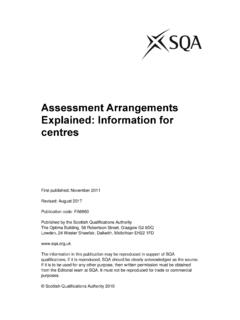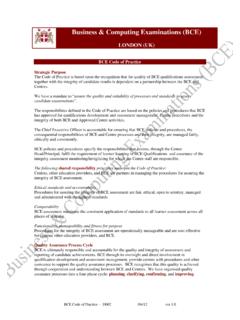Transcription of ADVENTURE ACTIVITIES LICENSING AUTHORITY The …
1 ADVENTURE ACTIVITIES LICENSING AUTHORITY The Approach to the Inspection of Providers within Scope of the ADVENTURE ACTIVITIES LICENSING Scheme to Permit Issue of a Licence Introduction In accordance with the Activity Centres (Young Persons Safety) Act 1995, the Health and Safety Executive (HSE) has been designated as the ADVENTURE ACTIVITIES LICENSING AUTHORITY (AALA) since April 2007. AALA is responsible for the implementation and oversight of the LICENSING regime for the provision of ADVENTURE ACTIVITIES for young people within scope of the ADVENTURE ACTIVITIES LICENSING Regulations 2004 (AALR).
2 This Statement explains how the approach to the inspection of providers by the ADVENTURE ACTIVITIES LICENSING Service1 (AALS) is compatible with the inspection approach adopted by the HSE in other permissioning regimes for which the HSE is responsible2. It is important to recognise the need for clarity where there is a prior role of the regulator in the permitting of an activity. The regime is further explained in L77 Guidance from the LICENSING AUTHORITY on the ADVENTURE ACTIVITIES LICENSING Regulations 2004 , as is the key concept of the culture of safety overall.
3 Permissioning A summary3 Permissioning regimes are an addition to the general framework of health and safety law. In this case, the regulator giving permission for licensable activities4 is AALA. Permissioning describes the regime where the start or continuation of particular ACTIVITIES is conditional upon a consent or licence etc. from the regulator. Parliament decided that, with limited exemptions, only those who hold a licence could provide specified ADVENTURE ACTIVITIES to young people under 18. Permissioning of licensable ACTIVITIES is not intended to provide a guarantee of health and safety in the operation of the duty holder s arrangements.
4 Even with a professional inspection strategy and regime, AALA cannot guarantee that there will be no major incidents. Responsibility for health and safety can only lie with the duty holder. However, the issuing of a licence indicates that AALS, on behalf of AALA, was satisfied that good safety management practice was in place at the date of issue and that AALS had a reasonable belief, based on the information to hand, that these good safety management practices would remain in place for the duration of the licence. 1 HSE has contracted the private, not for profit company, that was formerly the AALA to deliver the regime on a day to day basis.
5 This company and its ACTIVITIES are referred to as the ADVENTURE ACTIVITIES LICENSING Service (AALS). 2 Health and Safety Commission Policy Statement Our approach to permissioning regimes, 3 For full details of the HSE approach to permissioning regimes see - 4 Licensable ADVENTURE ACTIVITIES are trekking, climbing, caving and water sports, as defined in Appendix 1. AALS Inspectors are highly qualified and experienced outdoor professionals but their role is not to audit every aspect of a provider s safety system or verify every piece of information supplied by the provider.
6 It is a diagnostic sampling of the provider s safety management system with elements of detailed questioning about the management arrangements for the licensable ACTIVITIES . A professional judgement has to be made about the competence of the provider and their arrangements to comply with the law on the day of the inspection and how likely it is that compliance will continue throughout the licence period. The licence is required for and explicitly applies only to licensable ACTIVITIES (see Appendix 1) and the places specified on it.
7 Non-licensable ACTIVITIES are considered as part of the concept of a culture of safety overall but are not licensed. The aim of the LICENSING regime The aim of the ADVENTURE ACTIVITIES LICENSING scheme is to give assurance that good safety management practice is being followed so that young people can continue to have the opportunity to experience exciting and stimulating ACTIVITIES outdoor while not being exposed to avoidable risks of death and disabling injury (Guidance from the ADVENTURE ACTIVITIES LICENSING AUTHORITY , page1, paragraph 1 (L77))5.
8 More detail on the aim of the regime, the ACTIVITIES covered and the safety standards to be achieved are set out in L77. A fundamental part of the regime is the inspection of those providing defined ADVENTURE ACTIVITIES within scope of the regulations. The regulatory context and guidance for AALS inspections The general approach to LICENSING is set out in the Activity Centres (Young Persons ) Safety Act 1995 and the ADVENTURE ACTIVITIES LICENSING Regulations 2004. Further guidance on the regulations and expectations of providers and the AALS is given in L77.
9 Principles of inspection AALS inspections will satisfy the following principles: Proportionate - In a low risk, low accident-rate but potentially high consequence sector, inspections will be light-touch but suitably robust as has been the case since LICENSING was introduced. Lyme Bay was a prime example of a very infrequent event but one that caused multiple fatalities and much societal concern, hence the introduction of a LICENSING regime. Targeted - This primarily means being risk-based, but includes the obvious expectation that inspectors should focus on those aspects of provision which have the higher hazards and risks.
10 Licence duration is also risk-based being derived from the broad principles set out by AALA in L77 (paragraphs 70 - 73) and incorporated 5 L77 can be downloaded free at - into the Criteria for the Duration of Licences Inspector s Guidance Note6. This latter document gives an initial indication of the expected duration of a licence for a provider and hence the frequency of full licence inspections. For example, it assumes that larger scale or more complex provision presents more risk than smaller or less complex, and so larger scale or more complex provision is inspected more frequently.















